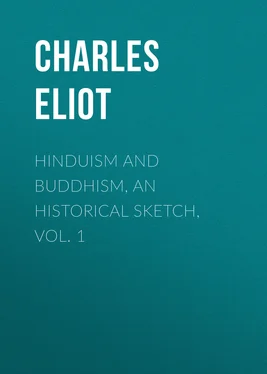Charles Eliot - Hinduism and Buddhism, An Historical Sketch, Vol. 1
Здесь есть возможность читать онлайн «Charles Eliot - Hinduism and Buddhism, An Historical Sketch, Vol. 1» — ознакомительный отрывок электронной книги совершенно бесплатно, а после прочтения отрывка купить полную версию. В некоторых случаях можно слушать аудио, скачать через торрент в формате fb2 и присутствует краткое содержание. Жанр: foreign_religion, Философия, Религиозная литература, foreign_psychology, foreign_antique, foreign_prose, на английском языке. Описание произведения, (предисловие) а так же отзывы посетителей доступны на портале библиотеки ЛибКат.
- Название:Hinduism and Buddhism, An Historical Sketch, Vol. 1
- Автор:
- Жанр:
- Год:неизвестен
- ISBN:нет данных
- Рейтинг книги:5 / 5. Голосов: 1
-
Избранное:Добавить в избранное
- Отзывы:
-
Ваша оценка:
- 100
- 1
- 2
- 3
- 4
- 5
Hinduism and Buddhism, An Historical Sketch, Vol. 1: краткое содержание, описание и аннотация
Предлагаем к чтению аннотацию, описание, краткое содержание или предисловие (зависит от того, что написал сам автор книги «Hinduism and Buddhism, An Historical Sketch, Vol. 1»). Если вы не нашли необходимую информацию о книге — напишите в комментариях, мы постараемся отыскать её.
Hinduism and Buddhism, An Historical Sketch, Vol. 1 — читать онлайн ознакомительный отрывок
Ниже представлен текст книги, разбитый по страницам. Система сохранения места последней прочитанной страницы, позволяет с удобством читать онлайн бесплатно книгу «Hinduism and Buddhism, An Historical Sketch, Vol. 1», без необходимости каждый раз заново искать на чём Вы остановились. Поставьте закладку, и сможете в любой момент перейти на страницу, на которой закончили чтение.
Интервал:
Закладка:
Early Chinese works prescribe that during the performance of ancestral rites, the ghosts are to be represented by people known as the personators of the dead who receive the offerings and are supposed to be temporarily possessed by spirits and to be their mouthpieces. Possession by ghosts or other spirits is, in popular esteem, of frequent occurrence in India, China, Japan and Indo-China. It is one of the many factors which have contributed to the ideas of incarnation and deification, that is, that gods can become men and men gods. In Europe the spheres of the human and divine are strictly separated: to pass from one to the other is exceptional: a single incarnation is regarded as an epoch-making event of universal importance. But in Asia the frontiers are not thus rigidly delimitated, nor are God and man thus opposed. The ordinary dead become powers in the spirit world and can bless or injure here: the great dead become deities: in another order of ideas, the dead immediately become reincarnate and reappear on earth: the gods take the shape of men, sometimes for the space of a human life, sometimes for a shorter apparition. Many teachers in India have been revered as partial incarnations of Vishnu and most of the higher clergy in Tibet claim to be Buddhas or Bodhisattvas manifest in the flesh. There is no proof that the doctrine of metempsychosis existed in Eastern Asia independently of Indian influence but the ready acceptance accorded to it was largely due to the prevalent feeling that the worlds of men and spirits are divided by no great gulf. It is quite natural to step into the spirit world and back again into this.
It will not have escaped the reader's attention that many of the features which I have noticed as common to the religions of Eastern Asia—such as the worship of nature spirits and ancestors—are not peculiar to those countries but are almost, if not quite, universal in certain stages of religious development. They can, for instance, be traced in Europe. But whereas they exist here as survivals discernible only to the eye of research and even at the beginning of the Christian era had ceased to be the obvious characteristics of European paganism, in Asia they are still obvious. Age and logic have not impaired their vigour, and official theology, far from persecuting them, has accommodated its shape to theirs. This brings us to another point where the linguistic difficulty again makes itself felt, namely, that the word religion has not quite the same meaning in Eastern Asia as in Mohammedan and Christian lands. I know of no definition which would cover Christianity, Buddhism, Confucianism and the superstitions of African savages, for the four have little community of subject matter or aim. If any definition can be found it must I think be based on some superficial characteristic such as ceremonial. Nor is there any objection to refusing the title of religion to Buddhism and Confucianism, except that an inconvenient lacuna would remain in our vocabulary, for they are not adequately described as philosophies. A crucial instance of the difference in the ideas prevalent in Europe and Eastern Asia is the fact that in China many people belong to two or three religions and it would seem that when Buddhism existed in India the common practice was similar. Paganism and spiritual religion can co-exist in the same mind provided their spheres are kept distinct. But Christianity and Islam both retain the idea of a jealous God who demands not only exclusive devotion but also exclusive belief: to believe in other Gods is not only erroneous; it is disobedience and disloyalty. But such ideas have little currency in Eastern Asia, especially among Buddhists. The Buddha is not a creator or a king but rather a physician. He demands no allegiance and for those who disobey him the only punishment is continuance of the disease. And though Indian deities may claim personal and exclusive devotion, yet in defining and limiting belief their priests are less exacting than Papal or Moslim doctors. Despite sectarian formulas, the Hindu cherishes broader ideas such as that all deities are forms and passing shapes of one essence; that all have their proper places and that gods, creeds and ceremonies are necessary helps in the lower stages of the religious life but immaterial to the adept.
It does not follow from this that Hindus are lukewarm or insincere in their convictions. On the contrary, faith is more intense and more widely spread among them than in Europe. Nor can it be said that their religion is something detachable from ordinary life: the burden of daily observances prescribed and duly borne seems to us intolerable. But Buddhism and many forms of Hinduism present themselves as methods of salvation with a simplicity and singleness of aim which may be paralleled in the Gospels but only rarely in the national churches of Europe. The pious Buddhist is one who moulds his life and thoughts according to a certain law: he is not much concerned with worshipping the gods of the state or city, but has nothing against such worship: his aims and procedure have nothing to do with spirits who give wealth and children or avert misfortune. But since such matters are of great interest to mankind, he is naturally brought into contact with them and he has no more objection to a religious service for procuring rain than to a scientific experiment for the same purpose. Similarly Confucians follow a system of ethics which is sufficient for a gentleman and accords a decorous recognition to a Supreme Being and ancestral spirits. Much concession to superstition would be reprehensible according to this code but if a Confucian honours some deity either for his private objects or because it is part of his duties as a magistrate, he is not offending Confucius. He is simply engaging in an act which has nothing to do with Confucianism. The same distinction often applies in Indian religion but is less clear there, because both the higher doctrine as well as ordinary ceremonial and mythology are described under one name as Hinduism. But if a native of southern India occasionally sacrifices a buffalo to placate some village spirit, it does not follow that all his religious notions are of this barbarous type.
Asiatic ideas as to the relations between religions are illustrated by an anecdote related to me in Assam. Christianity has made many converts among the Khasis, a non-Hindu tribe of that region, and a successful revival meeting extending over a week was once held in a district of professing Christians. When the week was over and the missionaries gone, the Khasis performed a ceremony in honour of their tribal deities. Their pastors regarded this as a woeful lapse from grace but no disbelief in Christianity or change of faith was implied. The Khasis had embraced Christianity in the same spirit that animated the ancient disciples of the Buddha: it was the higher law which spoke of a new life and of the world to come. But it was not understood that it offered to take over the business of the local deities, to look after crops and pigs and children, to keep smallpox, tigers and serpents in order. Nobody doubted the existence of spirits who regulate these matters, while admitting that ethics and the road to heaven were not in their department, and therefore it was thought wise to supplement the Christian ceremonies by others held in their honour and thus let them see that they were not forgotten and run no risk of incurring their enmity.
My object in this chapter is to point out at the very beginning that in Asia the existence of a duly labelled religion, such as Buddhism or Confucianism, does not imply the suppression of older nameless beliefs, especially about nature spirits and ghosts. In China and many other countries we must not be surprised to find Buddhists honouring spirits who have nothing to do with Buddhism. In India we must not suppose that the doctrines of Râmânuja or any other great teacher are responsible for the crudities of village worship, nor yet rashly assume that the villager is ignorant of them.
Читать дальшеИнтервал:
Закладка:
Похожие книги на «Hinduism and Buddhism, An Historical Sketch, Vol. 1»
Представляем Вашему вниманию похожие книги на «Hinduism and Buddhism, An Historical Sketch, Vol. 1» списком для выбора. Мы отобрали схожую по названию и смыслу литературу в надежде предоставить читателям больше вариантов отыскать новые, интересные, ещё непрочитанные произведения.
Обсуждение, отзывы о книге «Hinduism and Buddhism, An Historical Sketch, Vol. 1» и просто собственные мнения читателей. Оставьте ваши комментарии, напишите, что Вы думаете о произведении, его смысле или главных героях. Укажите что конкретно понравилось, а что нет, и почему Вы так считаете.












